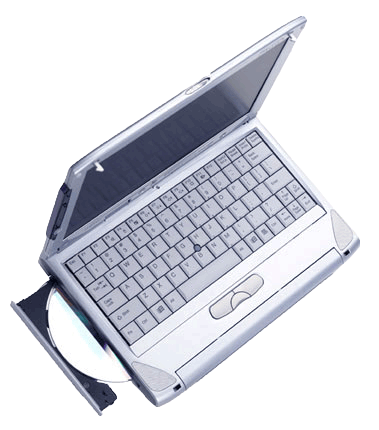😉 Head straight to the archive pages, if you want to skip my rambling:
Archived Leog.net forum threads
Archived direct-download files related to Fujitsu Lifebook P-series laptops
A Brief History

The LeoG.net Ultraportable forum was a public message board opened around 2001 and moderated by one Leo G. It was the place to go for discussions about subnotebook computers, particularly the Fujitsu variety, which are marketed as highly portable versions of regular laptops; they typically cost more and were more popular overseas (Asia, Japan in particular). The website was shut down in 2010 because spammers were abusing the forum, and the overall mobile computing technology had moved onto other types of devices. Why am I writing a little history here? Because I was part of that community for 7-8-ish years with a couple thousand posts, and it’s saddening to think of all that lost information and history. There were quite a few nice and helpful folks on the board. Anyway.
“Mini-notebooks” had come into existence in the mid/late 1990s. These were extremely small laptop computers–compared to regular sizes back then–that defined the new subnotebook philosophy and design, where portability and related issues like battery life were higher priority than raw computing power. This was when the line between handheld computers and traditional laptops began to blur. I actually had a Hitachi Visionbook Traveler at that point as well; boy, I remember using Photoshop 4 within Windows 95 (or was it 98?) on that tiny thing. I even used a portable solar cell array to charge it when outside. That mini-notebook wasn’t terribly powerful, but it sure turned heads! No, that wasn’t the most important thing–certainly, I moved around a lot and liked to work in various places outside a “home office.” Ultraportables have always been the least painful way to do this.
In late 2001 to early 2002, Fujitsu imported the Lifebook P-series. At the time, this particular Fujitsu line (Lifebook P-2000 in the United States and FMV Biblo Loox-T in Japan) broke all sorts of new ground: smallest laptop in the world to bear an internal modular bay drive that accepted a DVD/CD-RW drive or additional bay battery, a good number of connections including S-video-out so you could compute and watch video on a TV, and sported the Transmeta Crusoe processor. Well, the features may not seem like much today, but it was certainly ground-breaking at the time since miniaturization typically requires ingenuity on top of compromise. The early P-series won many accolades and might have even started a little user revolution in the States that valued portability and energy efficiency. *Many of the external links on the mirrored awards page don’t work anymore, but you can still find a fair bit of information about this original model through Google.
The Leog forum was built initially around this model of Fujitsu subnotebooks (P-2000 and P-1000) and, indirectly, the Transmeta chips that were credited to have pressured Intel enough to develop Pentium-M/Centrino packages:
03/11/2003 Computer Weekly:
For its part, Intel admitted at the recent Spring Intel Developer Forum that it decided to develop its Pentium-M processor, designed specifically for a mobile environment, as a response to Transmeta’s low-power approach to chip design with the original Crusoe processors. After more than two years of development, Intel will launch Centrino, a combination of the Pentium-M, a chipset, and a 802.11b wireless chip, on Wednesday.
Check this article at The Register (2000) for another take that says the same thing. That is, were it not for the little start-up’s marketing and support from early adopters (Fujitsu, Sharp, Sony, etc.), Intel probably would not have developed a line of ULV chips for efficient mobile computing. From the technological evolution standpoint, although I cheered on the underdog, it didn’t matter because consumers still won in getting more power-efficient processors. Suffice it to say, the Crusoe chip has long been retired, and its successor, the Efficeon, barely broke into the market before finally being fully replaced by Intel’s competing ULV processors.
The LeoG forum expanded to include not only Fujitsu subnotebooks, but Sony, other subnotebooks, general Windows/Linux forums for subnotebooks, a For Sale section, and such. Up to around 2008, subnotebooks were expensive niche products, still accounting for only a small fraction of overall laptop sales in the U.S.
And then “netbooks” happened. What were these things? In the categorical sense, they were around since about 2007 but didn’t really gain in popularity until 2008. Many of us old-timers on the forum puzzled over this marketing strategy and wondered where “netbooks” ended and “subnotebooks” began and how the entire laptop market would shift. The primary differences between these new netbooks and old-school subnotebooks were both performance and price, but primarily the latter. Leo decided not to set up a separate section for netbooks, but basically, we saw an overall decline in activity for all the traditional subnotebook discussion boards because netbooks were so much cheaper and gained market share at a record rate. Other devices like tablets (e.g. iPad) broke into the market just as aggressively and squeezed ultraportable laptops even more.
Leo’s decision to shut down the forum came rather suddenly, so I didn’t have anything interesting besides a restoration FAQ actually mirrored. I’ve tried to save some content and have organized it in the two major sections posted at the top of this page. It’s true that most of the content loses applicability with each passing day, but many of the old-school subnotebooks are still out there, and perhaps new (or old) users may find useful information here.